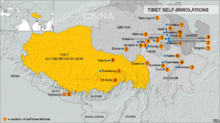
Back བོད་རིགས་ས་ཁུལ་དུ་བསྟུད་མར་རང་སྲེག་གི་དོན་རྐྱེན་ Tibetan Sebeupálení v Tibetu Czech Selbstverbrennungen in Tibet German Inmolación de tibetanos como protesta en China Spanish Auto-immolation de Tibétains French Tibetaanse zelfverbrandingen Dutch Samospalenia Tybetańczyków Polish การประท้วงโดยเผาตัวตายของชาวทิเบตในประเทศจีน Thai 藏區連環自焚事件 Chinese

As of May 2022, 160 monks, nuns, and ordinary people have self-immolated in Tibet[1][2][3][4] since 27 February 2009, when Tapey, a young monk from Kirti Monastery, set himself on fire in the marketplace in Ngawa City, Ngawa County, Sichuan.[5] According to the International Campaign for Tibet (ICT),[6] "Chinese police have beaten, shot, isolated, and disappeared self-immolators who survived."[7]
In 2011, a wave of self-immolations by Tibetans in Tibet, as well as in India and Nepal, occurred after the self-immolation of Phuntsog of 16 March 2011 in Ngawa County, Sichuan. Protests are ongoing.[8]
- ^ Fadiman, Anne (28 July 2020). "The Chinese Town That Became the Self-Immolation Capital of the World". The New York Times. ISSN 0362-4331. Retrieved 21 October 2020.
- ^ "Tibetan Monk Dies After Self-Immolating In Eastern Tibet". Free Tibet. Retrieved 20 May 2017.
- ^ Wong, Edward (11 April 2015). "Nun Sets Herself on Fire to Protest Chinese Rule in Tibet". The New York Times. Retrieved 11 April 2015.
She was the second woman to set herself on fire this year and the 138th Tibetan to do so since 2009 in Tibetan regions ruled by China, according to the International Campaign for Tibet, an advocacy group based in Washington.
- ^ "Self-immolations". International Campaign for Tibet. Retrieved 17 July 2022.
- ^ Cite error: The named reference
NYTKirtiwas invoked but never defined (see the help page). - ^ Self-immolation fact sheet, (2 December 2019), https://savetibet.org/tibetan-self-immolations/
- ^ Ross, Tracy (24 September 2019). "Tibet Is Still Burning". Outside. Retrieved 21 October 2020.
- ^ "Latest news & blogs | Free Tibet". freetibet.org. Retrieved 16 September 2020.
© MMXXIII Rich X Search. We shall prevail. All rights reserved. Rich X Search